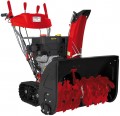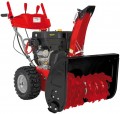Working width
The width of the strip of snow that the snow blower can clear in one pass. The larger the capture width, the fewer passes will be required to process the site, which is especially important on large areas. On the other hand, for processing small spaces, clearing individual paths, etc. significant width is not required (moreover, a “narrow” snow blower will pass more easily in a hard-to-reach place). The larger the capture width, the more powerful the engine, usually, ceteris paribus.
The most compact modern snow blowers have a working width of
less than 50 cm, these are mainly electric models of low power, although gasoline units are also found. A width of
50 – 60 cm can be called relatively small,
60 – 70 cm — medium, and in the largest models this figure
exceeds 70 cm.
Max. throw distance
The maximum distance to which the snow blower can throw the collected snow (for models without throwing distance adjustment, the operating range itself). This value is rather arbitrary, since snow can be strongly dispersed in flight. Nevertheless, it characterizes the capabilities of the unit well and allows you to compare it with other models.
Long range is important mainly when working on large areas — it allows you to throw snow across the cultivated area so that it does not have to be collected a second time. As for specific figures, the value
up to 10 m is considered relatively small,
11 – 15 m — average, and in the most "long-range" models this figure can be
16 m or more.
Movement
—
On wheels. The most common option among modern snow blowers. Wheeled units turn out to be quite light and manoeuvrable, and problems with cross-country ability can only arise on very rough terrain.
—
On caterpillars. Tracks provide less ground pressure than wheels and a larger contact area. This significantly increases the cross-country ability and allows you to effectively overcome pits, bumps, steep climbs and other difficult places that are “too tough” for wheeled units. On the other hand, tracks are noticeably more complex and expensive than wheels, they can only be used in self-propelled models, and all the advantages become noticeable only on very rough terrain. Therefore, it makes sense to pay attention to caterpillar snow blowers only if maximum cross-country ability is fundamentally important to you.
Engine size
The size of the engine installed in a gasoline or diesel (see "Engine type") snow blower. With the same type of internal combustion engine (see above), more displacement usually means more power and more fuel consumption.
Motor power
Snowblower motor power in horsepower.
The universal unit of power today is watts, but for petrol and diesel engines (see "Motor type"), the traditional designation in horsepower may also be given. 1 HP approximately equal to 735 watts.
The higher the motor power, the higher the performance of the snow blower, the better it handles with high dense snowdrifts and icy crust. However, more powerful engines consume more fuel, weigh more and cost more, and their use is not always justified. Detailed recommendations on choosing the optimal power for a specific situation can be found in special sources.
Motor power
Snowblower motor power in watts. This designation is used for all electric models; for units with an internal combustion engine (see "Motor type"), the designation in horsepower may also be given (see above).
The higher the motor power, the higher the snowblower's flow rate, the better it copes with high dense snowdrifts and icy crust. However, more powerful engines consume more fuel, weigh more and cost more, and their use is not always justified. Detailed recommendations on choosing the optimal power for a specific situation can be found in special sources.
Wheels diameter
Snow blower wheel diameter. Permeability primarily depends on this parameter: the larger the diameter of the wheels, the easier they will overcome obstacles in the form of curbs, stones, bumps, etc. This is especially important for self-propelled models (see "Design"); on the other hand, larger wheels require a more powerful engine. Therefore, if the unit is to be used on more or less flat terrain, it makes sense to choose a model with smaller wheels.
The smallest diameter found in modern snow blowers is about 12 – 13 cm; in the largest and heaviest models, it can reach 50 cm.

